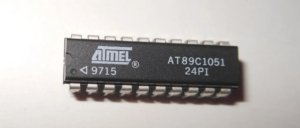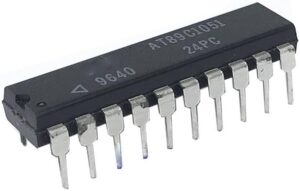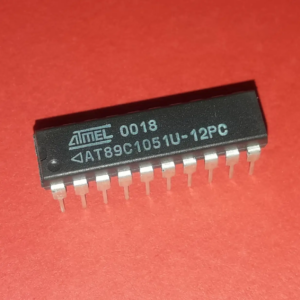Extracting microcontroller AT89C1051 code is a challenging task due to the secured and locked firmware protection embedded within this MCU. The AT89C1051 is an 8-bit microcontroller developed by Atmel, widely used in embedded systems. However, when the need arises to recover or duplicate its firmware, engineers often explore various methods to break its security features and extract its program data.

Methods to Crack AT89C1051 Firmware Protection
-
Decapsulation Attack: This technique involves chemically removing the microcontroller’s protective encapsulation to access its internal circuits. Once exposed, probing tools can be used to dump its EEPROM or flash memory.
-
EEPROM Dumping: If the program is stored in EEPROM, sophisticated dumping techniques can be used to extract binary data. However, protected regions may require additional decryption steps to recover the full firmware.
-
Fault Injection: By introducing power glitches or clock variations, attackers can bypass secured mechanisms and potentially access encrypted memory areas to extract sensitive program data.
-
Code Cloning via Reverse Engineering: In cases where partial source code is available, reverse engineering methods can be used to decode the program logic, allowing replication of the original firmware.
-
Software Exploits: Some microprocessors contain vulnerabilities that can be exploited to break security mechanisms. Finding such flaws may allow the extraction of locked firmware without physical attacks.
Challenges in Extracting AT89C1051 Code
-
Advanced Encryption: Many microcontrollers, including the AT89C1051, use secured encryption to prevent unauthorized copying or cloning of firmware.
-
Hardware Protection: Physical barriers and tamper-resistant designs make decapsulation and direct memory access difficult.
-
Legal and Ethical Concerns: Extracting locked firmware without authorization may violate intellectual property laws and ethical guidelines.

Conclusion
Extracting microcontroller AT89C1051 code requires highly advanced techniques such as decapsulation, EEPROM dumping, and fault injection. Due to strong encryption and security measures, cloning or duplicating its firmware remains a complex challenge. Always ensure legal compliance before attempting any microcontroller code recovery methods.

Extract Microcontroller AT89C1051 Code can help engineer to restore the firmware from MCU AT89C1051 memory which include flash and eeprom, unlock microcontroller security bit can turn the status of MCU to opened status;
The AT89C1051 is a low-voltage, high-performance CMOS 8-bit microcomputer with 1K byte of Flash programmable and erasable read only memory (PEROM). The device is manufactured using Atmel’s high density nonvolatile memory technology and is compatible with the industry standard MCS-51™ instruction set. By combining a versatile 8-bit CPU with Flash on a monolithic chip, the Atmel AT89C1051 is a pow-with 1K Byte Flash when Extract IC AT89s51 firmware.
AT89C1051 uerful microcomputer which provides a highly flexible and cost effective solution to many embedded control applications. The AT89C1051 provides the following standard features: 1K Byte of Flash, 64 bytes of RAM, 15 I/O lines, one 16-bit timer/counter, a three vector two-level interrupt architecture, a precision analog comparator, on-chip oscillator and clock circuitry.
In addition, the AT89C1051 is designed with static logic for operation down to zero frequency and supports two software selectable power saving modes. The Idle Mode stops the CPU while allowing the RAM, timer/counters, serial port and interrupt system to continue functioning. The Power Down Mode saves the RAM contents but freezes the oscillator disabling all other chip functions until the next hardware reset before Extract Microcontroller at89c55wd eeprom.
Port 1
Port 1 is an 8-bit bidirectional I/O port. Port pins P1.2 to P1.7 provide internal pullups. P1.0 and P1.1 require external pullups. P1.0 and P1.1 also serve as the positive input (AIN0) and the negative input (AIN1), respectively, of the on-chip precision analog comparator. The Port 1 output buffers can sink 20 mA and can drive LED displays directly.
When 1s are written to Port 1 pins, they can be used as inputs. When pins P1.2 to P1.7 are used as inputs and are externally pulled low, they will source current (IIL) because of the internal pullups.
Port 1 also receives code data during Flash programming and verification.
Port 3
Port 3 pins P3.0 to P3.5, P3.7 are seven bidirectional I/O pins with internal pullups. P3.6 is hard-wired as an input to the output of the on-chip comparator and is not accessible as a general purpose I/O pin. The Port 3 output buffers can sink 20 mA. When 1s are written to Port 3 pins they are pulled high by the internal pullups and can be used as inputs. As inputs, Port 3 pins that are externally being pulled low will source current (IIL) because of the pullups.
Port 3 also serves the functions of various special features of the AT89C1051 as listed below Port 3 also receives some control signals for Flash programming and verification. XTAL1 and XTAL2 are the input and output, respectively, of an inverting amplifier which can be configured for use as an on-chip oscillator, as shown in Figure 1. Either a quartz crystal or ceramic resonator may be used.
To drive the device from an external clock source, XTAL2 should be left unconnected while XTAL1 is driven as shown in Figure 2. There are no requirements on the duty cycle of the external clock signal, since the input to the internal clocking circuitry is through a divide-by-two flip-flop, but minimum and maximum voltage high and low time specifications must be observed.

